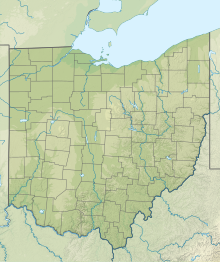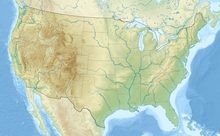Lawrence County Airpark (IATA: HTW[2], ICAO: KHTW, FAA LID: HTW) is a public use airport located two nautical miles (3.7 km) west of the central business district of Chesapeake, a village in Lawrence County, Ohio, United States. It is publicly owned by Lawrence County Board of Commissioners.[1] The airport lies across the Ohio River from Huntington, West Virginia.
Lawrence County Airpark | |||||||||||
|---|---|---|---|---|---|---|---|---|---|---|---|
| Summary | |||||||||||
| Airport type | Public | ||||||||||
| Owner | Lawrence County Board of Commissioners | ||||||||||
| Serves | Chesapeake, Ohio / Huntington, West Virginia | ||||||||||
| Opened | 1929 | ||||||||||
| Time zone | UTC−05:00 (-5) | ||||||||||
| • Summer (DST) | UTC−04:00 (-4) | ||||||||||
| Elevation AMSL | 568 ft / 173 m | ||||||||||
| Coordinates | 38°25′09″N 082°29′40″W / 38.41917°N 82.49444°W | ||||||||||
| Map | |||||||||||
 | |||||||||||
| Runways | |||||||||||
| |||||||||||
| Statistics (2020) | |||||||||||
| |||||||||||
History
editLawrence County Airpark, originally known as Huntington Airport, was established in 1929. In June of that year, John Paul Riddle of the Cincinnati-based Embry-Riddle Company completed negotiations for the establishment of an airport for the cities of the Kentucky, Ohio, West Virginia tri-state area. The company sought to expand their growing air mail and passenger routes east, via the Ohio River valley. The Embry-Riddle Company put up $100,000, with another $25,000 contributed by the Huntington Chamber of Commerce, $25,000 from the Huntington Bridge Company, and $25,000 from a local aviation booster club. The club enrolled 250 members, charging a membership fee of $100. This money was used to fund the airport project. The land was purchased primarily from a Mr. Joe L. Wilson, partner in the Huntington Bridge Company, who had used the land for farmland.[3]
Development of the land began in June but was slowed due to high levels of rain. Eventually several houses and a barn were removed, though two structures were initially left intact on the north side of the field for use as office and flight crew facilities.[3]
The new Huntington-Ironton-Chesapeake Airport opened on August 31, 1929, with a 3,600 feet (1,097 m) east-west sod landing strip (current site of runway 8/26) and a north-south strip 2,500 feet (762 m) in length (partially still in use as the airfield's only taxiway). The opening fell on Labor Day weekend, and massive celebrations were planned. Approximately 45,000 people attended the opening events throughout the weekend, which included aerial stunts and rides ($10 each).[3]
Ten planes, owned by the Embry-Riddle Company were stationed at the field. These included several Wacos. A Ford Tri-Motor was on display for opening day. There was a raffle for a free flight to Cincinnati's Lunken Field, and a folded-wing aircraft carrying local government and civic leaders Taxied across the bridge, led a parade around Huntington, West Virginia, then returned to the airport, extended its wings, and took them on an aerial tour.[3]
At the time of opening, the Embry-Riddle Company was to run the field and FBO. The company also opened a flight school. Embry-Riddle closed its flight school and withdrew service the next year, the result of disputes with the Huntington Chamber of Commerce over the building of a hangar facility.[3]
The 1930s were marked by repeated attempts to establish passenger and mail service to the H-I-C Airport. 1932 and 1936 saw relatively short attempts by American Airlines to set up service. In 1938, a permanent, regular service was begun. This was in part due to an agreement to lengthen and pave the main runway. As part of this deal, land was purchased for a 1,000-foot runway extension to the west in 1937. Air service lasted until April, 1945, when American closed their weather office and stopped mail and passenger services. The airline had been stopping an H-I-C when weight conditions allowed - by 1945 the runway was too short for AA's DC-3s to take off fully loaded. The runway had deteriorated markedly by 1945, and the main runway still had not been extended. This ultimately resulted in the 1947 creation of a Huntington Airport Authority to establish the current Tri-State Airport (HTS) in Wayne County, West Virginia.[3]
Facilities and aircraft
editLawrence County Airpark covers an area of 86 acres (35 ha) at an elevation of 568 feet (173 m) above mean sea level. It has one runway designated 8/26 with an asphalt surface measuring 2,998 by 70 feet (914 x 21 m).[1][4][5]
For the 12-month period ending October 2, 2020, the airport had 41,975 aircraft operations, an average of 115 per day. It was 99% general aviation, 1% air taxi, and <1% military. For the same time period, 28 aircraft were based at the airport: 26 single-engine and 2 multi-engine airplanes.[1][4][5]
There is one fixed-base operator on-field, Attitude Aviation. They currently have three Cessna 172 Skyhawks and one Beechcraft Bonanza available for rent, as well as maintenance and repair facilities. They also offer 100LL fuel, oil, and assorted charts and supplies for sale in addition to flight instruction.[6]
There is also a jump zone, Tri-State Skydivers, at the airport. They operate a modified Cessna 182, have skydiving instructors and parachutes available for rent, and operate most weekends throughout the year.
Facility Upgrades
editIn 2022, the airport received $82,770 to cover repairs and infrastructure upgrades. The airport used the money to rehabilitate the existing general aviation ramp as well as an existing taxiway to maintain structural integrity.[7][8] In 2023, the airport received $100,000 to continue these upgrades.[9]
Accidents and incidents
edit- On August 9, 1942, an aircraft operated by the Civil Air Patrol crashed near the airport soon after taking off.[10]
- On August 12, 1946, two aircraft collided above the airport, killing everyone onboard both planes, including multiple Navy officers.[10]
- On March 13, 2005, a Grumman American AA-5 was destroyed when it impacted terrain, shortly after takeoff from the Lawrence County Airpark. Witnesses report that the aircraft appeared to be high on its first approach, so it executed a go-around. The airplane continued around the traffic pattern and returned to land a second time. The second landing attempt appeared fast, and the intended touchdown point was "far down the runway." The pilot applied power again, and the airplane became airborne with a nose high attitude. The airplane cleared the 30-foot high trees located at the end of the runway and began to wobble; the right wing dropped, and the airplane descended to the ground about 1/4 mile from the airport. The probable cause of the accident was found to be the pilot's failure to maintain airspeed during the aborted landing, which resulted in an inadvertent stall.[11]
- On January 30, 2011, a Cessna 172P Skyhawk sustained substantial damage when it impacted the terrain after it hit trees during an aborted landing at the Lawrence County Airpark. The pilot reported a normal preflight, engine runup, and takeoff. On climbout, the pilot reported that the engine suddenly and continuously started to sound as if it was running “rough” and “missing." Without checking engine instruments, he immediately executed a steep left turn to return and land. Upon completing the turn, he realized he was too high to land on runway 26, so he retarded the throttle to idle, extended full flaps, executed a forward slip, and began a series of shallow S-turns to lose altitude. As it was 5-10 knots high and slightly fast crossing the runway's threshold, the aircraft floated 2,000 feet down the runway. After touchdown, the pilot used toe brakes to no effect and realized he would hit trees at the end of the runway, so he applied full power to go around and, though only trying to retract one notch, inadvertently retracted all of the wing flaps. The aircraft stalled as it brushed the tree tops, the left wing dropped, and the airplane impacted terrain. The probable cause of the accident was found to be the partial loss of engine power due to carburetor icing and the pilot’s delayed use of carburetor heat and failure to attain the proper touchdown point on the runway during the precautionary landing.[12]
- On March 9. 2016, a Remos GX was substantially damaged while landing at the Lawrence County Airpark. According to the pilot, during final approach, his airspeed was too fast. He decided to extend the landing flare in ground effect to bleed off the excess airspeed. As the airplane's main landing gear touched down on the runway, the airplane bounced. When the airplane settled back on the runway, the nose gear collapsed and the airplane exited the runway. The probable cause of the accident was found to be the pilot's unstable approach, which resulted in excessive airspeed during the touchdown, subsequent bounced landing, collapsed nose landing gear, and a runway excursion.[13]
See also
editReferences
edit- ^ a b c d FAA Airport Form 5010 for HTW PDF. Federal Aviation Administration. Effective 27 August 2009.
- ^ Accident history for HTW at Aviation Safety Network
- ^ a b c d e f Herald Dispatch, microfilm, 1929-1953.
- ^ a b "AirNav: KHTW - Lawrence County Airpark". www.airnav.com. Retrieved 2023-07-29.
- ^ a b "HTW - Lawrence County Airpark Airport | SkyVector". skyvector.com. Retrieved 2023-07-30.
- ^ "Attitude Aviation FBO Info & Fuel Prices at Lawrence County Airpark (KHTW)". FlightAware. Retrieved 2023-07-29.
- ^ Staff Reports (2022-06-13). "Lawrence County Airpark receives nearly $83K in federal funds". The Tribune. Retrieved 2023-07-29.
- ^ "Lawrence County Airpark receives nearly $83K in federal funds". Yahoo Sports. 2022-06-14. Retrieved 2023-07-30.
- ^ "Brown Announces $600,000 For Airport Improvements In Lawrence County | U.S. Senator Sherrod Brown of Ohio". www.brown.senate.gov. Retrieved 2023-07-30.
- ^ a b Martin, Martha J. (2019-03-03). "Chesapeake Ohio Airport History". The Lawrence Register. Retrieved 2023-07-30.
- ^ "Accident Grumman American AA-5 Traveler N6511L, 13 Mar 2005". Aviation Safety Network. Flight Safety Foundation. Retrieved 2023-07-30.
- ^ "Aviation Investigation Final Report". US National Safety Transportation Board. Retrieved 30 July 2023. This article incorporates text from this source, which is in the public domain.
- ^ "N201RQ accident description". planecrashmap.com. Retrieved July 29, 2023. This article incorporates text from this source, which is in the public domain.
External links
edit- Attitude Aviation, the airport's fixed-base operator
- Aerial photo as of 29 April 1995 from USGS The National Map
- Resources for this airport:
- FAA airport information for HTW
- AirNav airport information for HTW
- ASN accident history for HTW
- FlightAware airport information and live flight tracker
- SkyVector aeronautical chart for HTW

